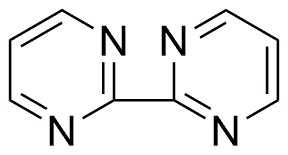2,2'-Bipyrimidyl is widely utilized in research focused on:
- Coordination Chemistry: This compound serves as a versatile ligand in coordination complexes, enhancing the stability and reactivity of metal ions in various chemical reactions.
- Photovoltaic Applications: It is used in the development of organic solar cells, where it helps improve the efficiency of light absorption and conversion into electrical energy.
- Organic Synthesis: Researchers leverage its properties to facilitate the synthesis of complex organic molecules, making it a valuable tool in pharmaceutical development.
- Electrochemical Sensors: The compound is employed in the design of sensors for detecting specific ions or molecules, benefiting industries such as environmental monitoring and food safety.
- Research in Catalysis: It plays a crucial role in catalyzing various chemical reactions, offering advantages such as increased reaction rates and selectivity compared to other ligands.
General Information
Properties
Safety and Regulations
Applications
2,2'-Bipyrimidyl is widely utilized in research focused on:
- Coordination Chemistry: This compound serves as a versatile ligand in coordination complexes, enhancing the stability and reactivity of metal ions in various chemical reactions.
- Photovoltaic Applications: It is used in the development of organic solar cells, where it helps improve the efficiency of light absorption and conversion into electrical energy.
- Organic Synthesis: Researchers leverage its properties to facilitate the synthesis of complex organic molecules, making it a valuable tool in pharmaceutical development.
- Electrochemical Sensors: The compound is employed in the design of sensors for detecting specific ions or molecules, benefiting industries such as environmental monitoring and food safety.
- Research in Catalysis: It plays a crucial role in catalyzing various chemical reactions, offering advantages such as increased reaction rates and selectivity compared to other ligands.
Documents
Safety Data Sheets (SDS)
The SDS provides comprehensive safety information on handling, storage, and disposal of the product.
Product Specification (PS)
The PS provides a comprehensive breakdown of the product’s properties, including chemical composition, physical state, purity, and storage requirements. It also details acceptable quality ranges and the product's intended applications.
Certificates of Analysis (COA)
Search for Certificates of Analysis (COA) by entering the products Lot Number. Lot and Batch Numbers can be found on a product’s label following the words ‘Lot’ or ‘Batch’.
Numéro de catalogue
Numéro de lot/série
Certificates Of Origin (COO)
This COO confirms the country where the product was manufactured, and also details the materials and components used in it and whether it is derived from natural, synthetic, or other specific sources. This certificate may be required for customs, trade, and regulatory compliance.
Numéro de catalogue
Numéro de lot/série
Safety Data Sheets (SDS)
The SDS provides comprehensive safety information on handling, storage, and disposal of the product.
DownloadProduct Specification (PS)
The PS provides a comprehensive breakdown of the product’s properties, including chemical composition, physical state, purity, and storage requirements. It also details acceptable quality ranges and the product's intended applications.
DownloadCertificates of Analysis (COA)
Search for Certificates of Analysis (COA) by entering the products Lot Number. Lot and Batch Numbers can be found on a product’s label following the words ‘Lot’ or ‘Batch’.
Numéro de catalogue
Numéro de lot/série
Certificates Of Origin (COO)
This COO confirms the country where the product was manufactured, and also details the materials and components used in it and whether it is derived from natural, synthetic, or other specific sources. This certificate may be required for customs, trade, and regulatory compliance.


